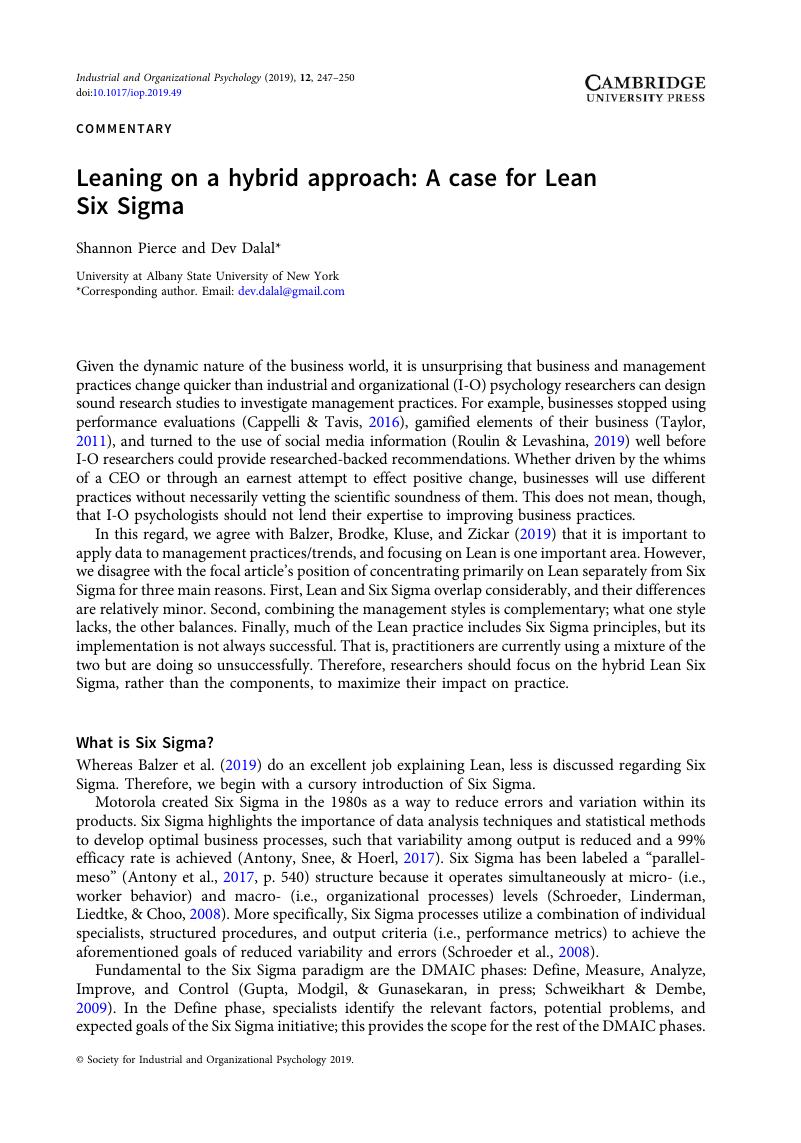No CrossRef data available.
Article contents
Leaning on a hybrid approach: A case for Lean Six Sigma
Published online by Cambridge University Press: 13 November 2019
Abstract
An abstract is not available for this content so a preview has been provided. Please use the Get access link above for information on how to access this content.

- Type
- Commentaries
- Information
- Copyright
- © Society for Industrial and Organizational Psychology 2019
References
Albliwi, S., Antony, J., Halim Lim, S. A., & van der Wiele, T. (2014). Critical failure factors of Lean Six Sigma: A systematic literature review. International Journal of Quality & Reliability Management, 31, 1012–1030.CrossRefGoogle Scholar
Antony, J. (2011). Six Sigma vs Lean: Some perspectives from leading academics and practitioners. International Journal of Productivity and Performance Management, 60, 185–190.CrossRefGoogle Scholar
Antony, J., Snee, R., & Hoerl, R. (2017). Lean Six Sigma: Yesterday, today and tomorrow. International Journal of Quality & Reliability Management, 34, 1073–1093.CrossRefGoogle Scholar
Arafeh, M., Barghash, M. A., Haddad, N., Musharbash, N., Nashawati, D., Al-Bashir, A., & Assaf, F. (2018). Using Six Sigma DMAIC methodology and discrete event simulation to reduce patient discharge time in King Hussein Cancer Center. Journal of Healthcare Engineering, 2018, 18 pages. doi:10.1155/2018/3832151CrossRefGoogle ScholarPubMed
Balzer, W. K., Brodke, M. H., Kluse, C., & Zickar, M. J. (2019). Revolution or 30-year fad? A role for I-O psychology in Lean management. Industrial and Organizational Psychology: Perspectives on Science and Practice, 12(3), 215–233.Google Scholar
Brooks, M. E., Dalal, D. K., & Nolan, K. P. (2014). Are common language effect sizes easier to understand than traditional effect sizes? Journal of Applied Psychology, 99, 332–340.CrossRefGoogle ScholarPubMed
Cappelli, P., & Tavis, A. (2016, October). The performance management revolution. Harvard Business Review. Retrieved from https://hbr.org/2016/10/the-performance-management-revolutionGoogle Scholar
Cherrafi, A., Elfezazi, S., Chiarini, A., Mokhlis, A., & Benhida, K. (2016). The integration of lean manufacturing, Six Sigma and sustainability: A literature review and future research directions for developing a specific model. Journal of Cleaner Production, 139, 828–846.CrossRefGoogle Scholar
George, M. L. (2002). Lean Six Sigma: Combining Six Sigma quality with Lean speed. New York, NY: McGraw-Hill.Google Scholar
Gupta, S., Modgil, S., & Gunasekaran, A. (In press). Big data in Lean Six Sigma: A review and further research directions. International Journal of Production Research. doi:10.1080/00207543.2019.1598599Google Scholar
Harris, L., & Fitzsimmons, M. (2019, May 2). Your taxes: Taking start-ups to the next level. Jerusalem Post. Retrieved from https://www.jpost.com/Jpost-Tech/Business-and-Innovation/Your-taxes-Taking-start-ups-to-the-next-level-588566Google Scholar
IASSC. (2019). IASSC accredited deployment programs. Retrieved from https://www.iassc.org/iassc-accredited-deployment-programs/Google Scholar
Improta, G., Cesarelli, M., Montuori, P., Santillo, L. C., & Triassi, M. (2018). Reducing the risk of healthcare-associated infections through Lean Six Sigma: The case of the medicine areas at the Federico II University hospital in Naples. Journal of Evaluation in Clinical Practice, 24, 338–346. doi:10.1111/jep.12844CrossRefGoogle Scholar
Kuncel, N. R., & Rigdon, J. (2012). Communicating research findings. In Schmitt, N. W. & Highhouse, S. (Eds.), Handbook of psychology: Industrial and organizational psychology, vol. 12 (pp. 43–58). New York, NY: Wiley.Google Scholar
Oguz, C., Kim, Y., Hutchinson, J., & Han, S. (2012). Implementing Lean Six Sigma: A case study in concrete panel production. In I. D. Tommelein & C. L. Pasquire (Eds.), Proceedings of the 20th Annual Conference of the International Group for Lean Construction. San Diego, CA: Montezuma Publishing.Google Scholar
Roulin, N., & Levashina, J. (2019). LinkedIn as a new selection method: Psychometric properties and assessment approach. Personnel Psychology, 72, 187–211.CrossRefGoogle Scholar
Schroeder, R. G., Linderman, K., Liedtke, C., & Choo, A. S. (2008). Six Sigma: Definition and underlying theory. Journal of Operations Management, 26, 536–554.CrossRefGoogle Scholar
Schweikhart, S. A., & Dembe, A. E. (2009). The applicability of Lean and Six Sigma techniques to clinical and translational research. Journal of Investigative Medicine: The Official Publication of the American Federation for Clinical Research, 57, 748–755. doi: 10.2310/JIM.0b013e3181b91b3aCrossRefGoogle ScholarPubMed
Taylor, C. (2011, May 2). For startups, timing is everything—just as bunchball. New York Times. Retrieved from https://archive.nytimes.com/www.nytimes.com/external/gigaom/2011/05/02/02gigaom-for-startups-timing-is-everything-just-ask-bunchb-88664.html?ref=technologyGoogle Scholar
Zhang, D. C. (2018). Art of the scale: Recommendations for sharing research with mainstream media and senior leaders. Industrial and Organizational Psychology: Perspectives on Research and Practice, 11, 589–593.CrossRefGoogle Scholar




